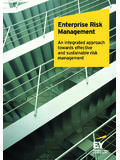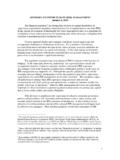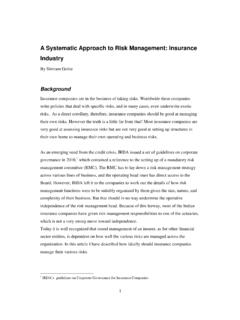Transcription of Credit Risk Modeling and Examination Techniques
1 Credit Risk Modeling and Examination Techniques2 Objectives Board and Senior management Oversight Policies, Procedures, and Limits Measurement, Monitoring, and MIS Modeling Internal Controls and AuditBoard and Senior management Oversight4 Board and Senior management Oversight Majority of work done to evaluate board and senior management oversight is done off-site and during preparation of the risk assessment Key objective is to evaluate the quality of management Primary exam technique is interviews with board members and senior management Also review board and committee packages5 Board and Senior management Oversight Questions to ask: Does management seem knowledgeable? Discuss specific problem loans Discuss the strategic direction of the portfolio Discuss the budget and growth expectations Discuss new or departed employees Discuss changes in products or processes and the risks brought on by those changes6 Board and Senior management Oversight Questions to ask (cont.)
2 : Does management seem aware of the risks present in their portfolio, underwriting guidelines, Discuss specific underwriting guidelines and limits and why management chose them Discuss the portfolio composition Does management seem aware of the health of the economy in their market? Discuss future expectations for the economy Discuss the impact of the economy on budget projections7 Board and Senior management Oversight Board and Committee Packages Are the board and senior management getting the right amount of information to make good decisions? Is the information useful? Is the information detailed or summary? Is there any written analysis with the information? Are Credit risk and Credit risk management discussed?
3 Are the board and senior management timely and effective in responding to audit, loan review, and exam findings?Policies, Procedures, and Limits9 Policies, Procedures, and Limits Off-site work is done to determine the adequacy of policies, procedures, and limits Risk assessment focuses on defining the bank s stated risk tolerance On-site work focuses on testing the adherence to, and enforcement of policies, procedures, and limits10 Testing Adherence to Policies, Procedures, and Limits Loan file review Adherence to loan approval policies Exceptions Conditional approvals Adherence to loan monitoring policies Covenants Periodic analysis (occurrence and quality) Accuracy and timeliness of internal loan grading Loan grade supporting analysis11 Testing Adherence to Policies, Procedures, and Limits Loan file review (cont.)
4 Problem loan identification Adequacy of loan impairment analysis for LLR accounting Adherence to accounting rules and regulations Documentation Loan docs Collateral docs Financial statements Review management reports all bank, legal, or regulatory limits should have a report to monitor compliance with the , Monitoring, and MIS13 Measurement, Monitoring, and MIS management Reports Types Exam Techniques Models What is a model and why models are used Types and uses Model validation Exam techniques14 Types of management Reports Traditional Past dues Charge offs/losses Non-accrual/Non-performing Technical exceptions Forward Looking New loan reports (volume, pricing, Credit quality)
5 Loss projections Pipeline reports Portfolio management Transition matrix Portfolio distribution Economic capital Credit scoring reports Vintage analysis Characteristic analysis Population analysis Credit risk model reports Product line analysis15 Exam Techniques for Evaluating management Reports Timely, Accurate, and Useful Old information is not actionable Inaccurate data will lead to bad reports which will lead to bad decisions Useless reports will be ignored or worse, misunderstood Too much detail/not enough detail Poor labeling Confusing information16 Exam Techniques for Evaluating management Reports Focus on how management reports are generated automated vs. manual Are there policies and procedures for generating the reports?
6 What is the process for getting a new report developed? Ask how each report is validated and by whom especially if the report is manually prepared Identify the data sources for each management report Loan systems and other databases, information from loan officers, models Are the data sources secure? How are they audited? Are they audited? Do they capture the right information?17 Exam Techniques for Evaluating management Reports Evaluate what each report is used for and what information they are trying to convey The higher up in the organization, the less detail is required, and the more global the reports should be Many times, separate written analysis should accompany the reports Summary reports should be backed up with supporting detailed reports Questions to ask: Is the body of reports that goes to each level of management appropriate for that level?
7 Who decides what is appropriate? How are new reports requested, developed, and produced?18 What Is a Model? Analytical approximation of reality that simplifies complex relationships A tool to help management solve a business problem A set of very specific assumptions about how the world behaves19 Reasons for Wider Use of Models Better technology at a lower cost Improved financial theories and engineering Industry acceptance of more active and dynamic risk management More competition in the financial sector20 Types of Models Commercial Credit models Probability of default (PD) models Loss given default (LGD) models Exposure at default (EAD) models Consumer Credit models Default models Bankruptcy models Behavioral models Loss given default (LGD) models Exposure at default (EAD)
8 Models21 Types of Commercial Credit Models Probability of default (PD) models For a group of borrowers with similar characteristics, predicts the number of borrowers that are likely to default over a specific time horizon, 1 year Is based on the characteristics of the borrower Loss given default (LGD) models Attempts to predict the amount of loss in a Credit in the event of default Is based on the characteristics of the facility, collateral covenants, etc. Exposure at default (EAD) models For unfunded lines of Credit , attempts to determine the amount of exposure that will exist at the time of default Is based on the characteristics and purpose of the facility and the behavior of the borrower22 Commercial Credit Models Relatively new compared to consumer Credit models Lack of data is the biggest problem in model development PD models are further along than LGD and EAD models23 Commercial Credit Models General characteristics of commercial Credit models Strictly define what elements are considered in the measurement of Credit risk Strictly define the relative weight of those items considered in the measurement of Credit risk Can produce either a relative measure of Credit risk or a
9 Specific measure of Credit risk depending on whether judgmental factors are considered in the model The probability of default or loss given default for credits with these characteristics is X% Credits with these characteristics are stronger or weaker than other credits24 Consumer Credit Models EAD and LGD models are basically the same for commercial and consumer Consumer models are based on borrower characteristics, but focus on different characteristics Default models For a group of borrowers with similar characteristics, predicts the number of borrowers that are likely to default over a specific time horizon, 1 year Focuses on amount of Credit available to borrower, stability of borrower, and history of delinquency25 Consumer Credit Models Bankruptcy models For a group of borrowers with similar characteristics, predicts the number of borrowers that are likely to file bankruptcy over a specific time horizon, 1 year Focuses on amount and the types of Credit used by the borrower Behavioral models Focuses on the behavior of an individual customer and the lender s experience with that customer to focus the bank s collection and marketing efforts Focuses on payment history and spending patterns26 Model Validation Models require validation because there is potential for error in Modeling , which can lead to poor management decisions.
10 Data Assumptions Calculations Output The existence of potential errors in Modeling is called model risk27 Why Does Model Risk Exist? At some level a model is always incorrect There is the potential for poor decisions from erroneous results Actual losses Foregone income from opportunity costs Some of the worst of the risks center around implementation28 Guiding Principles of Model ValidationBalance the benefits for risk management with the costs of validationBUTAll models need to be validated at some level30 Model Components Data: organize and confirm Stratification Aggregation Theoretical approach and code: select the right model and ensure that adequate vendor support exists Assumptions.
















